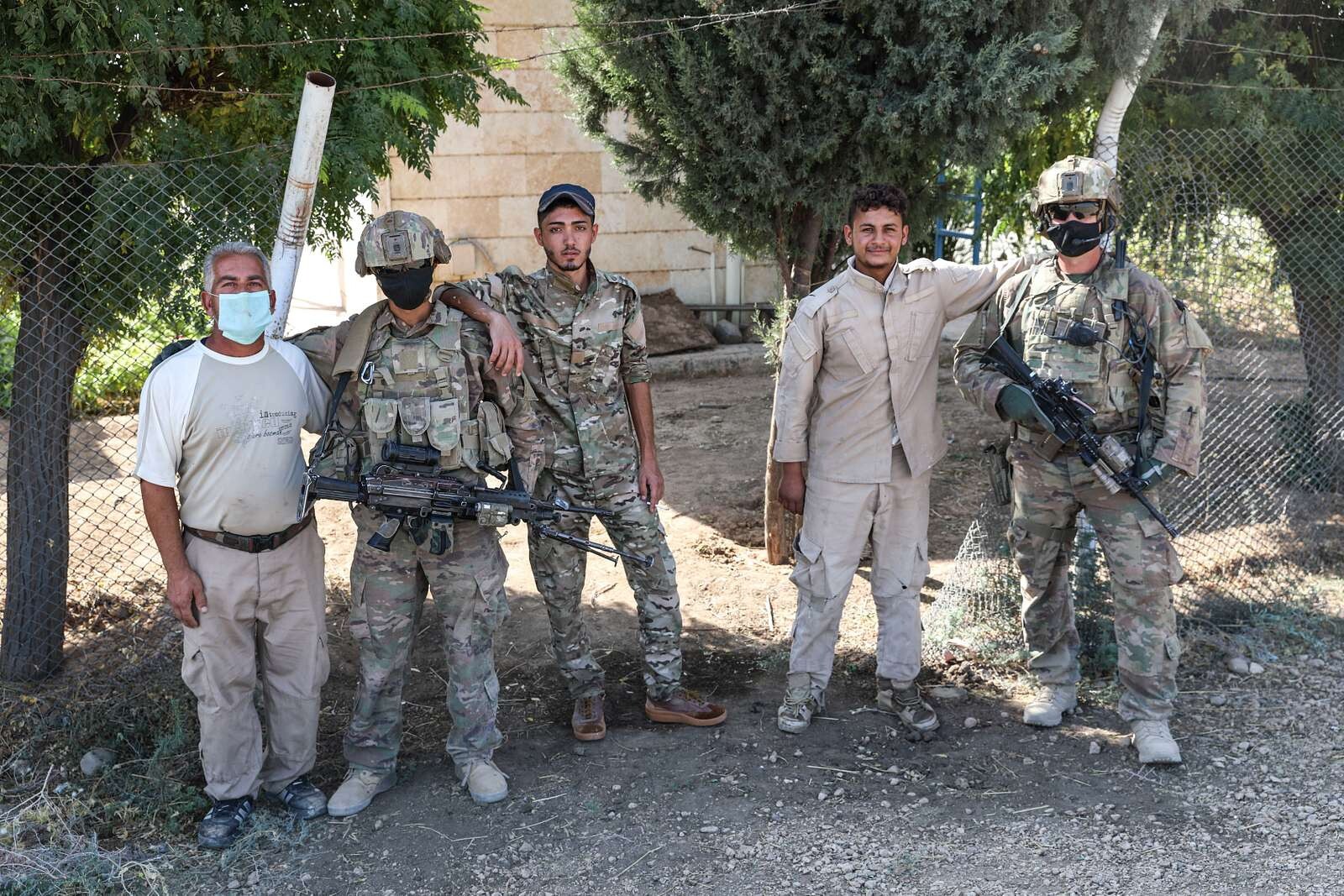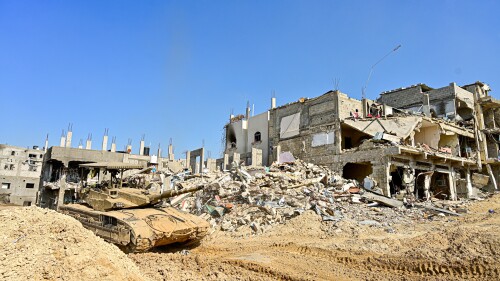Turkey is gearing up for a new invasion of Syria and possibly expanded campaigns in Iraq, claiming it is a fight against terrorism. A recent bombing in Ankara was blamed on Kurdish groups in Syria, but it appears Ankara arrested a perpetrator who is not linked to any Kurdish group.
Since 2019, the Syrian situation has been largely at a stalemate, with authority divided among three de facto enclaves, each dependent on the sponsorship of outside powers. The Assad regime, guaranteed by Russia and Iran, controls around 60-65% of Syria’s territory, including the coastline and the main cities. The US-backed, Kurdish-dominated Syrian Democratic Forces hold most of the area east of the Euphrates, comprising roughly 30% of Syria’s area. Turkey, in partnership with the self-styled “Syrian National Army” (the remnants of the Sunni Islamist rebellion, remustered under Turkish auspices) and with the jihadi Hayat Tahrir al-Sham (HTS) group, controls an area in the northwest, comprising around 10% of Syrian territory.
Syria’s de facto partition has mostly held since early 2018.
This de facto partition has mostly held since early 2018. Turkey shifted the balance somewhat in October-November 2019, with a ground incursion east of the Euphrates. This resulted in the establishment of an enclave of Turkish-controlled territory biting into the Kurdish-controlled area, and in the deployment of regime and Russian forces east of the Euphrates in order to deter further Turkish advances. Since then, the military situation on the ground has been static, the broader question of Syria’s future unresolved.
There are currently indications of renewed movement. Specifically, Turkish President Recep Tayyip Erdogan has been carrying out an air campaign against targets in the Kurdish/US area since November 20. The Turkish president has already threatened a ground incursion, with the intention of pushing the Kurdish forces back 30 kilometers from the border and conquering three towns – Tal Rifaat, Manbij and Kobani. Kurdish sources told The Jerusalem Post that the Syrian Kurdish leadership had expected the invasion in late November. Its postponement appears to be the result of both American and Russian representations to and pressure on Ankara. Sources suggest, however, that the danger has not yet passed.
Turkey’s Erdogan threatens invasion of Syria while trying diplomacy
Alongside the threats of invasion, Erdogan appears to now be embarked on a course of diplomacy.
On Thursday, December 15, the Turkish president expressed his desire for a three-way meeting with himself, Russian President Vladimir Putin and Syrian President Bashar Assad. “Let us get together as the leaders. I offered this to Mr. Putin, and he received it positively. Thus, a series of contacts would be launched...
“We want to take a tripartite step as Syria-Turkey-Russia.”
“We want to take a tripartite step as Syria-Turkey-Russia,” the Turkish president told reporters on his way back from a trip to Turkmenistan, as reported on the Al-Monitor news website. The statements followed talks in Istanbul on December 8-9 between the Turkish and Russian deputy foreign ministers, and a phone conversation between Putin and Erdogan on December 11.
This is a far cry from the Erdogan of a decade ago. Turkey emerged as the first and most determined supporter of the Islamist insurgents who sought to destroy the Assad regime. In 2012, in the early days of the insurgency, Erdogan effectively opened the border to the rebels, allowing them to ferry weaponry and supplies into Syria. Now, as the last protector of what is left of the revolt, the Turkish leader appears to be pursuing a very different goal – namely, rapprochement with the Assad regime, under Russian auspices.
The Turkish leader’s stance indicates that while he may have for the moment abandoned his ambition to stand at the head of a group of Sunni Islamist regional states, this is not leading him to return to a pro-US regional policy. Rather, he appears to be seeking to draw closer to Russia in order to further weaken and eventually nullify the Kurdish-led entity in eastern Syria. Erdogan considers that this body, aligned with the US in its fight against ISIS, is a front for the PKK (Kurdish Workers Party), with which Turkey has been at war since 1984. His efforts since 2015, when it became clear that the rebellion was not going to defeat Assad, have been mainly directed toward seeking the destruction of the Kurdish-led area.
In this regard, Turkey finds natural partners in Russia and Assad. Assad wants to reassert his nominal control over the entirety of Syrian sovereignty. Russia supports this goal too, as does its ally Iran, and both would like to see the departure of the US troops currently guaranteeing the continued existence of the Kurdish-led enclave.
The Kurdish area, formally known as the Autonomous Administration of North and East Syria (AANES), has been gradually whittled away by Turkey in three military operations since 2016. In 2019, the Turkish incursion required the Kurds to invite the regime and Russians into their area to prevent a further Turkish advance. If forced to choose between the Turks or Assad, the Syrian Kurds will, unsurprisingly, opt for Assad. For Erdogan, this raises the attractive proposition of using the Assad regime as a kind of anvil for the Turkish hammer, between which the Syrian Kurds will be crushed.
In 2019, regime forces did not attempt to reimpose Assad’s political authority east of the Euphrates. Contrary to some predictions, the regime at that time satisfied itself with beefing up its military presence on the border only. But the episode served to further erode the area of control and authority of the AANES. It appears that this pattern is to Erdogan’s liking: Threats of Turkish action necessitate closer links between the Kurds and the regime, leading to the further weakening of the Kurds. The next episode of this dynamic, under Russian auspices, seems to be under way.
Russia’s proposals at this stage appear to resemble the methods used by Moscow to whittle away at rebel-controlled areas five years ago. Moscow is suggesting that the SDF fighters withdraw from Kobani and Manbij, leaving only Kurdish paramilitary police “Asayish” forces, which would then come under regime command. The Kurds, according to Al-Monitor, have accepted these demands. Turkey is now demanding additional Kurdish concessions.
The choreography of all this seems fairly clear. The key player absent in the dynamic, meanwhile, is the United States. It is the US which guarantees the continued existence of the AANES area. It does so, however, without a political commitment of any kind. Relations are officially limited to cooperation in the ongoing battle against the Islamic State. US interlocutors make clear to the Kurdish leadership that they will not necessarily be in Syria for the long term. The US, therefore, is not opposed to the negotiations between the AANES and the Assad regime.
The “hands off” position of the US is likely to doom Syrian Kurds to continued slow erosion of their area of control.
This “hands off” position of the US is likely to doom the Syrian Kurds to the continued slow erosion of their area of control. The absence of a clear US commitment in Syria may reflect a view which sees this arena as a backwater, of little strategic relevance at the present time. If so, this view is mistaken. Syria is one front for a broader, coalescing alliance between Moscow and Tehran, which also takes in the battlefields of Ukraine and the domestic turmoil in Iran (Moscow, according to a recent report on the TV channel Iran International, is advising and assisting the Iranians in the suppression of the protests). The US-guaranteed enclave is important strategic real estate that gives the opposing side in this alliance a presence in Syria and an ability to oppose, frustrate or block and contain the ambitions of Moscow and Tehran. Turkey is seeking to position itself midway between the sides, gaining advantage from both. The problem may be that strategic thinking on the pro-US side has yet to catch up with the emergent reality in this context. Until it does, the advantage will be with the Russian-Iranian side as it moves with Turkish cooperation toward an endgame intended to deliver it strategic victory in the Syrian arena.









